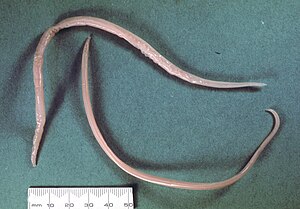Pig roundworm
| Pig roundworm | ||||||||||||
|---|---|---|---|---|---|---|---|---|---|---|---|---|

Pig roundworm |
||||||||||||
| Systematics | ||||||||||||
|
||||||||||||
| Scientific name | ||||||||||||
| Ascaris suum | ||||||||||||
| Goeze , 1782 |
The Ascaris suum ( Ascaris suum ) is a parasitierender nematode of the genus of roundworms . It is widespread worldwide and affects people as well as pigs .
description
The pig roundworm has a spindle-shaped body that tapers at both ends. The females are about 20 to 30 centimeters long, the males are significantly smaller. The mouth at the front end can be recognized by the three lips that surround it. The anus lies on the belly side just before the rear end. The sexual opening of the females is located approximately at the end of the first third of the body in an annular constriction. Male roundworms have a cloaca and can be recognized by the spiral curling of the rear end. Morphologically , the pig roundworm ( Ascaris suum ) cannot be distinguished from the human roundworm ( Ascaris lumbricoides ). The eggs are egg-shaped, golden-brown and thick-shelled, they have a bumpy, uneven surface.
Way of life
Pig roundworms live in the small intestine of their hosts , the pigs, and feed on the intestinal contents. The eggs deposited there get outside with the faeces . They only develop further when they come into contact with oxygen. After two moults in the egg, an approximately 200 micrometer small youth or larval stage develops. This leaves the egg only after it has entered the host's intestine after ingestion through the mouth. There it breaks through the intestinal epithelium and migrates into the blood vessel system. In the host's liver, it grows to two millimeters in length within ten days and is then transported with the blood to the lungs, where it breaks through the capillaries in the alveoli and leaves the blood vessel system. It sheds its skin again and is carried by the ciliated epithelium of the windpipe into the throat of the host and swallowed with saliva. It reaches the small intestine again, where it grows into sexually mature pig roundworm after another molt.
literature
- Volker Stoch & Ulrich Welsch: Kükenthal's guidelines for the zoological internship. 23. Edit again Edition. Spectrum Akad. Verl., Heidelberg, Berlin 1999 ISBN 3-8274-0901-2
Individual evidence
- ↑ http://ticker-grosstiere.animal-health-online.de/20060628-00000
- ↑ Gaspary, Kist, Stein, Infektiologie des Gastrointestinal Tract , Springer Verlag, Berlin 2006, p. 45.